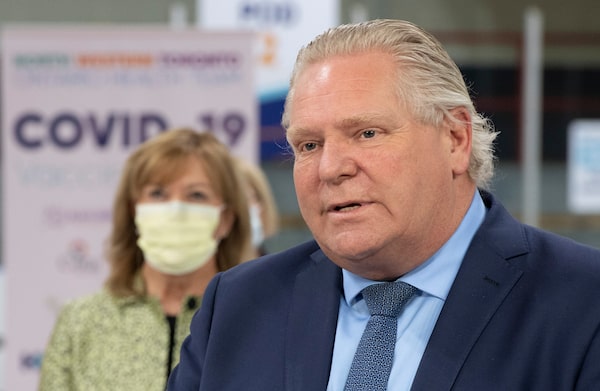
Ontario Premier Doug Ford speaks during the daily briefing at a mass vaccination centre in Toronto on March 30, 2021.Frank Gunn/The Canadian Press
With Easter weekend approaching and a third wave of COVID-19 causing infection rates to shoot upward, premiers and health officials warned against holiday gatherings and the leader of Canada’s largest province said new public-health restrictions could be days away.
Ontario Premier Doug Ford said Tuesday he could announce new measures this week to contain the rapid spread of new and more contagious variants of COVID-19 and to keep the province’s hospitals from reaching a tipping point.
“Everything’s on the table right now,” Mr. Ford said. “So folks, be prepared. I’m asking you, don’t make plans for Easter. ... I won’t hesitate to lock things down if we have to. I did it before. I’ll do it again.”
Quebec Premier François Legault, who recently loosened restrictions to allow 250 people to gather in places of worship, also said Tuesday that he is worried about Easter. Case counts started to grow this week in areas outside Montreal where the government loosened restrictions in early March.
Extra police will be on patrol to enforce Quebec’s ban on private gatherings, and the Premier said he is considering special measures for the holiday weekend.
“We are worried and we are asking ourselves, do we need to do something special for Easter weekend?” Mr. Legault said. “It is not the time for family celebrations.”
He also said he is most worried about the city of Gatineau on the Quebec side of the border from Ottawa, which has had a spike in cases and has a shortage of hospital beds in normal times. He said his government needed more co-operation with Ontario to implement stricter measures in Gatineau.
In Alberta, Chief Medical Health Officer Deena Hinshaw has warned that this week – with students off for spring break heading into the Easter weekend – could be critical in determining the course of infections in the province. She said the province could consider new restrictions if the situation in the province, already precarious, deteriorates further.
In Ontario, despite Mr. Ford’s warning about Easter, gatherings and close contact with those from a different household are already not allowed under health rules.
Mr. Ford, who recently loosened some limits on businesses even in the province’s strictest “red” and “grey” zones of pandemic restrictions, said he was extremely concerned about rising numbers of younger people with COVID-19 now in the province’s intensive-care units.
The province has said that it could enact an “emergency brake” in any region with sharply rising cases that would return it to the “shutdown” that all of Ontario faced in January, when only stores deemed essential were left open and the province was blanketed with a “stay-at-home” order. The opposition NDP and Liberals accused Mr. Ford of failing to act quickly enough to stop the virus.
On Monday, B.C. announced a “circuit-breaker,” shutting bars and restaurants, fitness classes and indoor worship services for three weeks to stem rising infections of virus variants. The move to restrict religious services reversed a recent deal reached with faith groups to allow indoor worship.
Canada as whole recorded 4,573 new COVID-19 cases on Tuesday, with 2,336 of them in Ontario, that province’s sixth consecutive day above the 2,000 mark. A month ago, the province was seeing just more than 1,000 cases a day.
Ontario had 410 patients with COVID-19-related illness in its ICUs as of Monday – just shy of the peak of 420 from the second wave. That’s well above thresholds that have already forced the postponement of hundreds of thousands of surgeries. ICU doctors have warned a continued surge could force the triaging of patients who need lifesaving care.
“The situation is the most serious it’s been in the pandemic,” Anthony Dale, president and chief executive officer of the Ontario Hospital Association, said in an interview.
In all there were 1,819 patients of all kinds in Ontario’s ICUs, a load that has forced hospitals in hot spots to fly patients in Toronto to beds as far away as Kingston, 260 kilometres to the east.
Mr. Dale said the province’s ICUs have an overall maximum capacity of 2,300 ICU patients. They have also been asked to find another 300 critical-care spaces in anticipation of a potential worst-case scenario in the coming weeks. But hospital staff operating at these maximum levels, he said, would be in an unprecedented crisis.
Ontario’s external COVID-19 Science Advisory Table is expected to release new projections about the virus’s growth in the province on Thursday.
Ryan Mallough, director of provincial affairs for Ontario at the Canadian Federation of Independent Business, said his organization is also concerned about rising cases – but noted some businesses in Toronto and neighbouring Peel Region are still shuttered from previous lockdowns.
He said he hopes the government can avoid drastic measures – and will provide adequate supports for businesses that suffer if it cannot.
“I’m hoping it can be a more targeted approach this time … as opposed to that full stay-at-home order level blanket shutdown,” he said.
With reports from Les Perreaux in Montreal, James Keller in Calgary and Wendy Cox in Vancouver
Our Morning Update and Evening Update newsletters are written by Globe editors, giving you a concise summary of the day’s most important headlines. Sign up today.
 Jeff Gray
Jeff Gray Laura Stone
Laura Stone